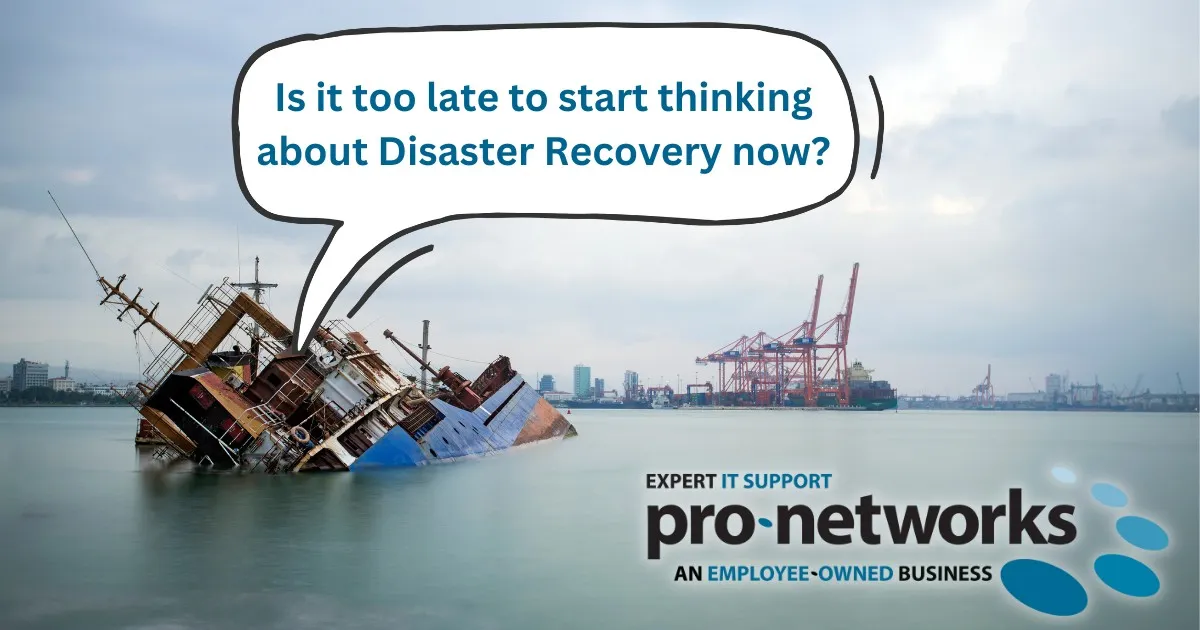
They call it the unthinkable because, well, no one likes to think about it. But you need to. You absolutely have to. And you need a robust plan for when it happens.
When Disaster Comes Calling
A complete collapse of your IT is a dreadful experience. It’s hard to think of a department or team in a modern business that doesn’t rely on IT to do their jobs. Without IT, they are going to be inefficient at best and completely dead in the water at worst.
This impacts you in a number of ways. Because you can’t function as normal your ability to deliver your products or services to your customers is reduced, or halted altogether. This places your customers under pressure, and can weaken or break established business relationships. Business is business. If you can’t deliver, they have to find someone who can.
An under-performing workforce is bad enough, but a workforce rendered inactive by a complete IT outage is a huge financial drain. You’re paying them to do nothing. Obviously, a full-scale IT catastrophe takes its toll on your bottom line, your business relationships and staff morale. And through it all everyone is stressed and panicking, making a bad situation worse.
Nowadays, the majority of IT outages are due to a cyber attack. That’s not to say that server hardware failures or other disasters such as a fire at your premises don’t cause outages. They do. But you’re much more likely to experience a full-scale IT catastrophe as a result of a ransomware cyber incident than for any other reason.
Backups Are Great
Backups are great, but they only solve part of the problem. They allow you to restore your data to new, or repaired, hardware. But you need to acquire or repair the hardware, install an operating system, configure users and all your other network settings, and then restore your data.
That all takes time. There are some finite time periods that cannot be reduced. Restoring your data, for example, takes as long as it takes. And the more data you have, the longer it’ll take. Regardless of how fast you can transfer it to your new computer or server, it’s still bottle-necked by the speed you can write it to the hard drives.
Backups work brilliantly at safeguarding data. But, but as an integral step in disaster recovery, restoring entire systems from backups just adds too much drag to the recovery phase. And in a crisis, time is money.
Some backups create an image of your entire server, operating system as well. That means you can restore your operating system, settings, and data in one go. But it also means you’re transferring and writing even more information to do so.
Why Disaster Recovery is Different
Disaster recovery is different. While backups are about saving data, disaster recovery is about business continuity. Disaster recovery aims to get you up and running on alternate physical or virtual hardware, as fast as possible. That takes the pain of downtime and lost revenue away.
And once you’re up and running, the remedial work required to restore your actual systems can take place in parallel, in a considered and controlled fashion.
Historically, disaster recovery has been an expensive option, one that was often viewed as a luxury. Who can afford to have redundant, stand-by equipment on hand, just as a precaution in case of a catastrophic incident? And of course, they have to be housed off-site so that they don’t get affected by any physical damage from flood or fire at your premises.
You’re not forced into procuring a second premises of course, you can store them in a data center so that they’re accessible and ready when you need them. But that’s a significant on-going cost.
The Pro-Networks Disaster Recovery as a Service Solution
Pro-Networks have designed and built a solution that can have your business IT up, running and accessible to your staff with timescales measured in hours not days.
We replicate your server using Microsoft’s HyperV replication features. This creates a snapshot image of each of your servers—operating system, settings and data—off-site from your premises. The replicated images can be stored in our data center at our head office, or at a commercial, third-party data center.
Every five minutes the remote image is updated with the changes from your live servers. That’s 288 updates in a 24 hour period. The advantages are, your snapshots are never more than five minutes behind your live systems, and if you want to restore your system to a particular point during the last 24 hours, that can be done easily. And best of all, the images themselves can be converted to running virtual instances of your servers, on the hardware in the data center. We’ll connect your staff to the remote servers—that look exactly the same as the ones they use every other day—and they can get back to work.
Meanwhile, we’ll be working on restoring your live systems and tackling the actual disaster.
Special Offers for 2023 & 2024
It doesn’t matter how well-engineered a solution is, if no one can afford it. By leveraging our own data center, we’re able to offer disaster recovery as a service starting at £125 per month. Commercial data centers may charge more, but if you want to, we’ll work with them and house your disaster recovery images in their data center for you.
In the event of a catastrophic event that requires the use of the service, you’ll have no further costs because the engineering time is drawn from your support agreement.
Usually, there’s an initial set-up and configuration fee of £150. We waive this for our premier customers, so they can get protected straight away with no set-up charges.
When someone deletes a file, restoring it from backup is nice and simple. But when the unthinkable happens, you’ll be glad you thought ahead and subscribed to our Disaster Recovery as a Service.
